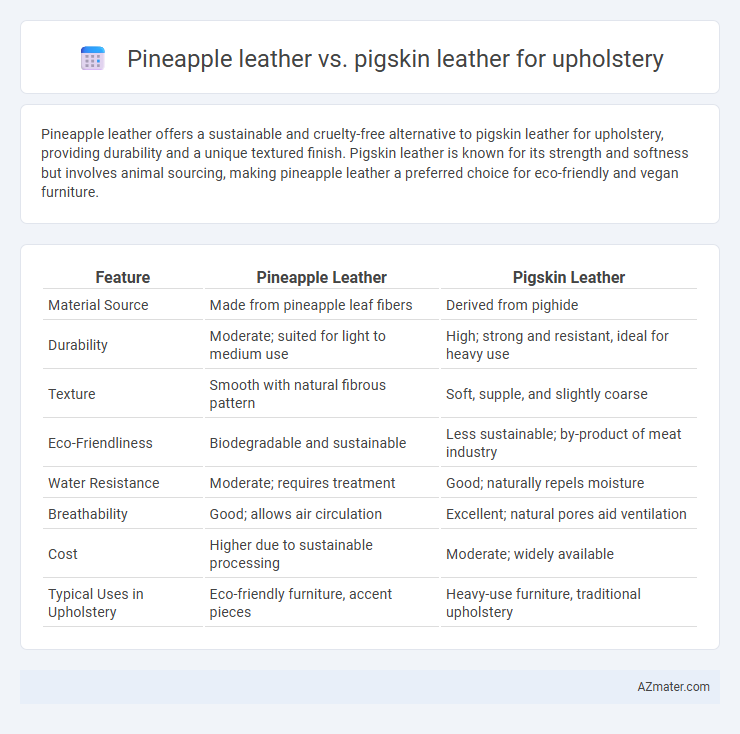Pineapple leather offers a sustainable and cruelty-free alternative to pigskin leather for upholstery, providing durability and a unique textured finish. Pigskin leather is known for its strength and softness but involves animal sourcing, making pineapple leather a preferred choice for eco-friendly and vegan furniture.
Table of Comparison
| Feature | Pineapple Leather | Pigskin Leather |
|---|---|---|
| Material Source | Made from pineapple leaf fibers | Derived from pighide |
| Durability | Moderate; suited for light to medium use | High; strong and resistant, ideal for heavy use |
| Texture | Smooth with natural fibrous pattern | Soft, supple, and slightly coarse |
| Eco-Friendliness | Biodegradable and sustainable | Less sustainable; by-product of meat industry |
| Water Resistance | Moderate; requires treatment | Good; naturally repels moisture |
| Breathability | Good; allows air circulation | Excellent; natural pores aid ventilation |
| Cost | Higher due to sustainable processing | Moderate; widely available |
| Typical Uses in Upholstery | Eco-friendly furniture, accent pieces | Heavy-use furniture, traditional upholstery |
Introduction to Pineapple Leather and Pigskin Leather
Pineapple leather, crafted from the fibrous leaves of pineapple plants, offers an eco-friendly alternative to traditional materials with its sustainable sourcing and biodegradable properties. Pigskin leather, derived from the hide of pigs, is prized for its durability, natural breathability, and soft, flexible texture, making it a popular choice for upholstery with long-lasting wear resistance. Comparing these materials highlights pineapple leather's innovative, plant-based origins against pigskin leather's time-tested strength and comfort.
Material Origins and Sustainability
Pineapple leather, derived from the fibrous leaves of the pineapple plant, offers a sustainable alternative to pigskin leather, which comes from the hides of pigs typically raised in intensive farming environments. Pineapple leather production uses agricultural waste, significantly reducing environmental impact and promoting circular economy practices, whereas pigskin leather often involves higher water usage, chemical processing, and greenhouse gas emissions. Choosing pineapple leather for upholstery supports eco-friendly material sourcing and reduces reliance on animal-based products with higher ecological footprints.
Production Processes Compared
Pineapple leather, produced from the fibrous leaves of the pineapple plant through enzymatic treatment and compression, offers a sustainable alternative with a lower environmental impact than pigskin leather, which is derived from the hide of pigs using traditional tanning methods involving chemicals like chromium salts. The production of pineapple leather involves fewer water and energy resources, relying on agricultural waste, whereas pigskin leather requires a more resource-intensive process with significant water consumption and waste generation. Both materials provide durability for upholstery, but pineapple leather aligns with eco-friendly manufacturing trends due to its plant-based origin and reduced chemical usage.
Environmental Impact Assessment
Pineapple leather, derived from pineapple leaf fibers, offers a sustainable alternative to pigskin leather by utilizing agricultural waste, significantly reducing environmental footprint in upholstery production. Pigskin leather involves resource-intensive livestock farming, contributing to higher greenhouse gas emissions, water consumption, and land use compared to plant-based materials. Selecting pineapple leather for upholstery supports eco-friendly practices by minimizing deforestation and chemical pollution typical of conventional leather tanning processes.
Durability and Longevity in Upholstery
Pineapple leather offers impressive durability due to its plant-based fibers, resisting wear and maintaining appearance under moderate use, but it may not match the heavy-duty endurance of pigskin leather. Pigskin leather demonstrates superior longevity with high tensile strength, natural oils that resist cracking, and excellent abrasion resistance, making it ideal for long-lasting upholstery in high-traffic areas. Choosing between pineapple and pigskin leather for upholstery depends on balancing eco-friendly material benefits with the robust durability requirements of the intended application.
Comfort and Aesthetic Appeal
Pineapple leather offers a unique combination of sustainable innovation and breathable texture, providing superior comfort with a soft, supple feel ideal for upholstery. Pigskin leather, known for its durability and natural grain, delivers a luxurious aesthetic with a rich texture that ages gracefully over time. Both materials enhance interior spaces, with pineapple leather adding an eco-friendly appeal and pigskin offering timeless elegance.
Maintenance and Care Requirements
Pineapple leather requires gentle cleaning with a damp cloth and mild soap, avoiding harsh chemicals to preserve its eco-friendly fibers, while pigskin leather demands regular conditioning and protection from moisture to maintain its natural durability and suppleness. Pineapple leather is more resistant to stains and easier to maintain due to its synthetic nature, whereas pigskin leather develops a patina over time that requires attentive care to prevent cracking and discoloration. Both materials benefit from keeping away from direct sunlight and sharp objects to extend their longevity in upholstery applications.
Cost Analysis and Market Availability
Pineapple leather, derived from pineapple leaf fibers, is generally more expensive than pigskin leather due to limited production and sustainable sourcing processes. Pigskin leather remains widely available and cost-effective, benefiting from established supply chains and traditional tanning methods. Market availability for pineapple leather is currently niche and growing, primarily targeting eco-conscious consumers willing to invest in premium upholstery materials.
Ethical Considerations in Material Choices
Pineapple leather, derived from agricultural waste, offers a sustainable and cruelty-free alternative to traditional pigskin leather, reducing environmental impact and animal welfare concerns in upholstery. Pigskin leather involves animal slaughter and resource-intensive processing, raising ethical questions about animal rights and ecological footprint. Choosing pineapple leather supports eco-friendly practices and aligns with ethical consumer values seeking innovative materials with lower environmental and moral costs.
Final Verdict: Choosing the Right Leather for Upholstery
Pineapple leather offers sustainable, eco-friendly benefits with a distinctive texture and durability suitable for modern upholstery, while pigskin leather provides traditional strength, breathability, and a classic aesthetic preferred in high-use furniture. Selecting the right leather hinges on prioritizing environmental impact versus timeless performance; pineapple leather excels in sustainability and uniqueness, whereas pigskin excels in proven resilience and comfort. Final verdict depends on whether eco-conscious innovation or established durability aligns better with your upholstery needs.

Infographic: Pineapple leather vs Pigskin leather for Upholstery
 azmater.com
azmater.com